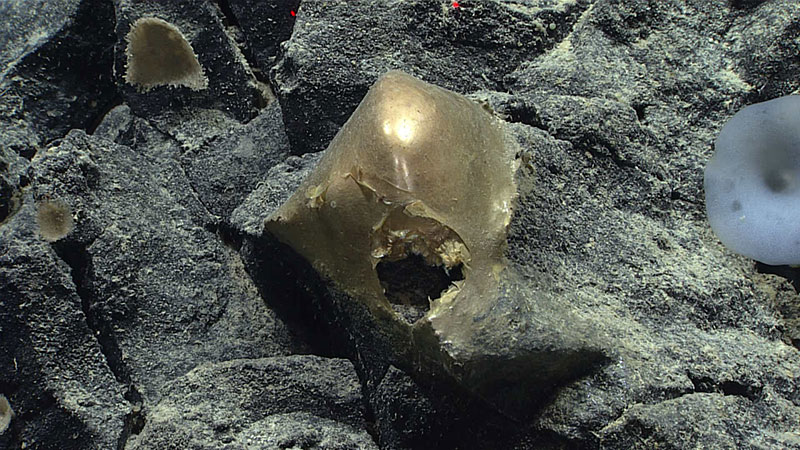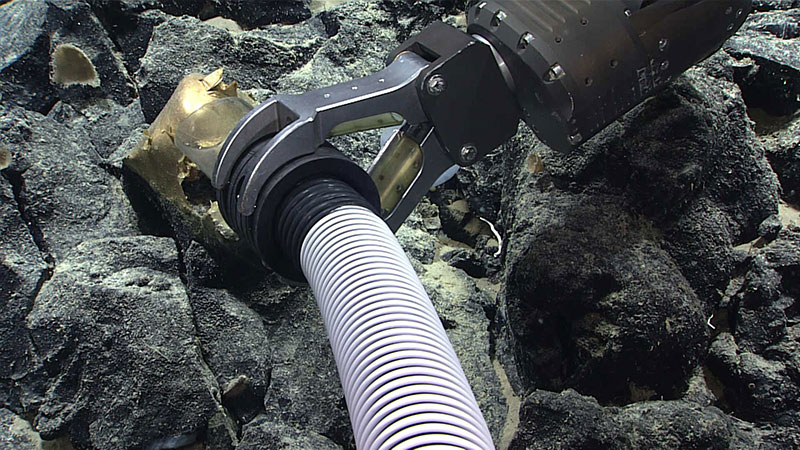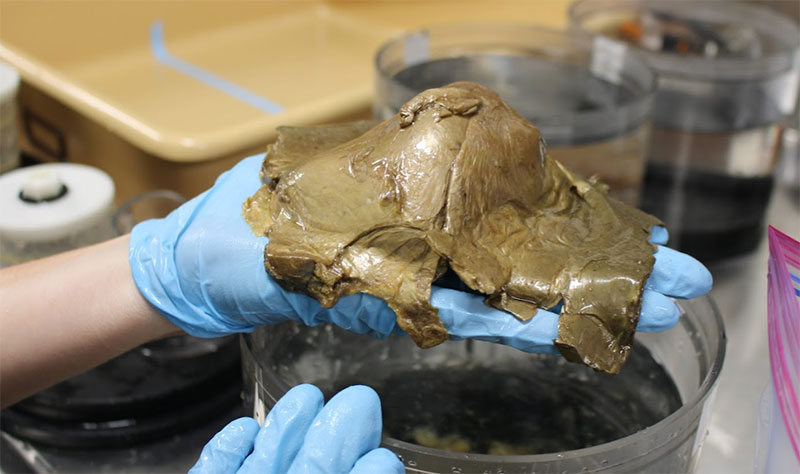Unidentified Golden Specimen Captures Public Imagination
On August 30, 2023, while using remotely operated vehicles to dive on a small seamount in the Gulf of Alaska, mission personnel aboard NOAA Ship Okeanos Explorer came across a confounding sight. While gliding over a rocky outcrop at a depth of about 3,300 meters (2 miles), they found what one of the videographers onboard helping to document the dive first referred to as a “yellow hat.”
This as-of-yet identified collection taken on Dive 07 (August 30, 2023) of the Seascape Alaska 5 expedition generated a lot of interest and curiosity from scientists, viewers, and beyond. The specimen was seen adhered to a rocky outcropping at a depth of about 3,300 meters (2 miles) and was collected via suction sampler for further study. Video courtesy of NOAA Ocean Exploration, Seascape Alaska. Download largest version (mp4, 95.9 MB)
Amid a smattering of white sponges, this smooth, gold, dome-shaped specimen, a little over 10 centimeters (4 inches) in diameter, was tightly adhered to a rock. A small hole or tear near its base revealed a similarly colored interior. As cameras zoomed in, scientists were stumped as to its identification, with initial thoughts ranging from a dead sponge attachment, to coral, to an egg casing. While the find perplexed and inspired an air of creative imagination in many watching the dive live, it has also captured public imagination, inspiring a host of news articles across the country and beyond. Invoking almost fairytale-like imagery, the specimen has since been dubbed a “golden orb” and even a “golden egg,” by media outlets.
"Isn’t the deep sea so delightfully strange?” said NOAA Ocean Exploration’s Sam Candio, expedition coordinator for the ongoing Seascape Alaska 5: Gulf of Alaska Remotely Operated Vehicle Exploration and Mapping expedition that the still-unidentified specimen was found on. He elaborated, “While we were able to collect the 'golden orb' and bring it onto the ship, we still are not able to identify it beyond the fact that it is biological in origin. We likely won't learn more until we are able to get it into a laboratory setting where we can continue to pull from the collective expertise of the scientific community with more sophisticated tools than we are able to maintain on the ship. While somewhat humbling to be stumped by this finding, it serves as a reminder of how little we know about our own planet and how much is left to learn and appreciate about our ocean.”

This unidentified specimen, seen in situ on a rocky outcropping at a depth of about 3,300 meters (2 miles), was seen on August 30, 2023, during Dive 07 of the Seascape Alaska 5: Gulf of Alaska Remotely Operated Vehicle Exploration and Mapping expedition. Image courtesy of NOAA Ocean Exploration, Seascape Alaska. Download larger version (jpg, 1.3 MB).

This unidentified specimen, seen on Dive 07 of the Seascape Alaska 5: Gulf of Alaska Remotely Operated Vehicle Exploration and Mapping expedition, was collected using a suction sampler on remotely operated vehicle Deep Discoverer. Image courtesy of NOAA Ocean Exploration, Seascape Alaska. Download largest version (1.3 MB).

This unidentified specimen, photographed in the wet lab on NOAA Ship Okeanos Explorer, was seen and collected on August 30, 2023, during Dive 07 of the Seascape Alaska 5: Gulf of Alaska Remotely Operated Vehicle Exploration and Mapping expedition. Image courtesy of NOAA Ocean Exploration, Seascape Alaska. Download largest version (jpg, 444 KB)
While it's still unclear if the golden dome is associated with a known species, a new species, or perhaps represents an unknown life stage of an existing one, Sam elaborated on the importance of ocean exploration. “New species have the potential to reveal new sources for medical therapies and vaccines, food, energy, and other societal benefits and knowledge. Collectively, the data and information gathered during this expedition will help us close gaps in our understanding of this part of the planet, so we can better manage and protect it.”
The Seascape Alaska 5: Gulf of Alaska Remotely Operated Vehicle Exploration and Mapping expedition continues through September 16, 2023, with livestreamed remotely operated vehicle dives happening daily from approximately 9 a.m. AKDT/10 a.m. PDT/1 p.m. EDT to 4 p.m. AKDT/5 p.m. PDT/8 p.m. EDT. Anyone can join live at https://oceanexplorer.noaa.gov/livestreams/welcome.html
B-Roll Footage for Download
All footage courtesy NOAA Ocean Exploration, Seascape Alaska.
First sighting of the "orb" (footage begins at approximately 01:55) on the seafloor at a depth of approximately 3,300 meters (2 miles). Download ProRes version (5.4 GB)
Collection of the "orb" by remotely operated vehicle (ROV) pilots from the Global Foundation for Ocean Exploration using the suction sampler on ROV Deep Discoverer at a depth of approximately 3,300 meters (2 miles). Download ProRes version (5.4 GB)
Last updated September 8, 2023
Published September 7, 2023
Relevant Expedition: Seascape Alaska 5: Gulf of Alaska Remotely Operated Vehicle Exploration and Mapping